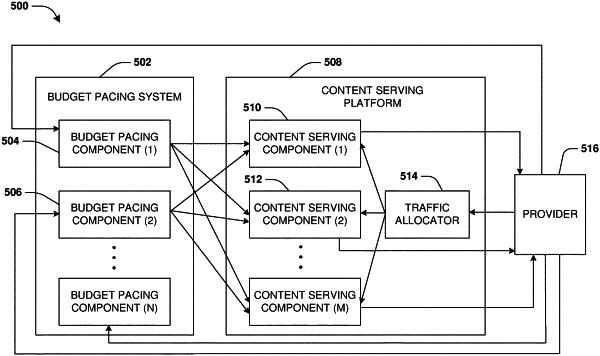| CPC G06Q 30/0273 (2013.01) [G06Q 30/0243 (2013.01); G06Q 30/0246 (2013.01); G06Q 30/0254 (2013.01)] | 20 Claims |

|
1. A method for online advertising campaign management for delivering online advertisements, comprising:
executing, on a processor of a computing device, instructions that cause the computing device to perform operations, the operations comprising:
assigning a first budget pacing component, of a budget pacing system, to control bidding by a first content serving component, of a content serving platform, for a set of content items to display, wherein the budget pacing system communicates with the content serving platform;
assigning a second budget pacing component, of the budget pacing system, to control bidding by a second content serving component, of the content serving platform, for the set of content items to display;
controlling the first budget pacing component to control the bidding by the first content serving component according to a first portion of a content item budget, wherein the controlling the first budget pacing component to control the bidding by the first content serving component comprises:
tracking spending by the first content serving component for each content item; and
controlling the first content serving component to stop bidding if subsequent bidding would cause the first content serving component to spend more than the first portion of the content item budget and steal at least some of a second portion of the content item budget;
controlling the second budget pacing component to control the bidding by the second content serving component according to the second portion of the content item budget;
after controlling the bidding by the first content serving component and the second content serving component for a period of time:
determining a first spend amount of over the period of time by the first budget pacing component;
determining an overall spend over the period of time by a plurality of budget pacing components comprising the first budget pacing component and the second budget pacing component; and
dynamically modifying traffic shares allocated to the first content serving component and the second content serving component, wherein the dynamically modifying comprises modifying a first traffic share allocated to the first content serving component to a first modified traffic share and modifying a second traffic share allocated to the second content serving component to a second modified traffic share;
based upon the dynamically modifying traffic shares, determining a new spend amount for the first budget pacing component that avoids a spend spike by setting the new spend amount based upon (i) the first modified traffic share allocated to the first content serving component and (ii) the overall spend over the period of time by the plurality of budget pacing components comprising the first budget pacing component and the second budget pacing component;
responsive to determining the new spend amount, setting a spend amount of the first budget pacing component to be the new spend amount;
determining performance of the first content serving component and the second content serving component in serving the set of content items based upon a comparison of (i) a function of revenue of the first content serving component associated with utilization of a first model for assigning probabilities of user interactions with content items to (ii) a function of revenue of the second content serving component associated with utilization of a second model for assigning probabilities of user interactions with content items; and
ranking the first content serving component associated with the first model and the second content serving component associated with the second model based upon the performance of the first content serving component and the second content serving component.
|